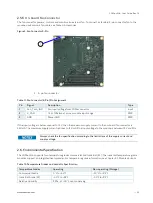
COMe-cEL6 - User Guide, Rev.1.3
// 26
2.4.
Electrical Specification
The module powers on by connecting to a carrier board via the COMe interface connector. Before connecting the
module to the carrier board, ensure that the carrier board is switch off and disconnected from the main power supply
at the time of connection. Failure to disconnect the main power supply from the carrier board could result in personal
injury and damage to the module and/or carrier board. The COMe interface connector pins on the module limits the
amount of power received.
The module powers on by connecting to the carrier board using the Interface connector.
Before connecting the module’s interface connector to the carrier board’s corresponding
connector, ensure that the carrier board is switch off and disconnected from the main power
supply. Failure to disconnect the main power supply could result in personal injury and
damage to the module and/or carrier board.
Observe that only trained personnel aware of the associated dangers connect the module,
within an access controlled ESD-safe workplace.
2.4.1.
Power Supply Specification
The COMe-cEL6 supports a supply voltage of 12 V (single power rail voltage) and a wide input voltage range of 8.5 V
to 20 V. Other supported voltages are 5 V standby and 3.3 V RTC battery input.
Table 6: COMe-cEL6 Electrical Specification
Supply Voltage Range (VCC)
8.5 V to 20 V
Nominal Supply Voltage (VCC)
12 V
Standby Voltage
5 V ±5 %
Note: 5V Standby voltage is not mandatory for operation
RTC
2.8 V to 3.47 V (3.0 V nominal)
Only connect to an external power supply delivering the specified input rating and
complying with the requirements of Safety Extra Low Voltage (SELV) and Limited Power
Source (LPS) of UL/IEC 60950-1 or (PS2) of UL/IEC 62368-1.
To protect external power lines of peripheral devices, make sure that the wires have the
right diameter to withstand the maximum available current and the enclosure of the
peripheral device fulfils the fire-protection requirements of IEC/EN 62368-1.
If any of the supply voltages drops below the allowed operating level longer than the
specified hold-up time, all the supply voltages should be shut down and left OFF for a time
long enough to allow the internal board voltages to discharge sufficiently.
If the OFF time is not observed, parts of the board or attached peripherals may work
incorrectly or even suffer a reduction of MTBF. The minimum OFF time depends on the
implemented PSU model and other electrical factors and must be measured individually for
each case.
















































